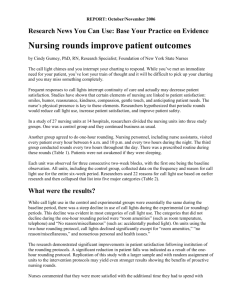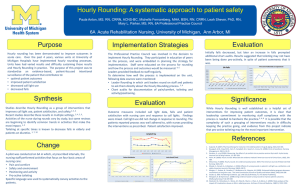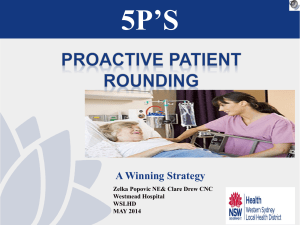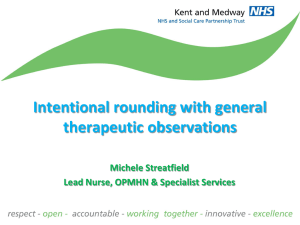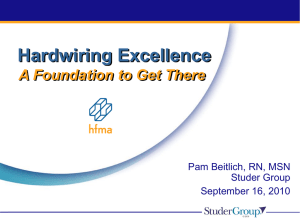Slide 1
advertisement
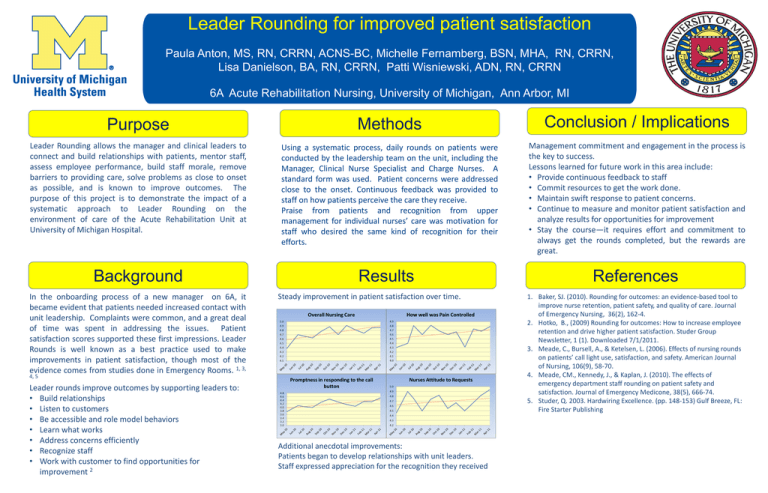
Leader Rounding for improved patient satisfaction Paula Anton, MS, RN, CRRN, ACNS-BC, Michelle Fernamberg, BSN, MHA, RN, CRRN, Lisa Danielson, BA, RN, CRRN, Patti Wisniewski, ADN, RN, CRRN 6A Acute Rehabilitation Nursing, University of Michigan, Ann Arbor, MI Purpose Methods Conclusion / Implications Leader Rounding allows the manager and clinical leaders to connect and build relationships with patients, mentor staff, assess employee performance, build staff morale, remove barriers to providing care, solve problems as close to onset as possible, and is known to improve outcomes. The purpose of this project is to demonstrate the impact of a systematic approach to Leader Rounding on the environment of care of the Acute Rehabilitation Unit at University of Michigan Hospital. Using a systematic process, daily rounds on patients were conducted by the leadership team on the unit, including the Manager, Clinical Nurse Specialist and Charge Nurses. A standard form was used. Patient concerns were addressed close to the onset. Continuous feedback was provided to staff on how patients perceive the care they receive. Praise from patients and recognition from upper management for individual nurses’ care was motivation for staff who desired the same kind of recognition for their efforts. Management commitment and engagement in the process is the key to success. Lessons learned for future work in this area include: • Provide continuous feedback to staff • Commit resources to get the work done. • Maintain swift response to patient concerns. • Continue to measure and monitor patient satisfaction and analyze results for opportunities for improvement • Stay the course—it requires effort and commitment to always get the rounds completed, but the rewards are great. Background In the onboarding process of a new manager on 6A, it became evident that patients needed increased contact with unit leadership. Complaints were common, and a great deal of time was spent in addressing the issues. Patient satisfaction scores supported these first impressions. Leader Rounds is well known as a best practice used to make improvements in patient satisfaction, though most of the 1, 3, evidence comes from studies done in Emergency Rooms. Results Steady improvement in patient satisfaction over time. 4, 5 Leader rounds improve outcomes by supporting leaders to: • Build relationships • Listen to customers • Be accessible and role model behaviors • Learn what works • Address concerns efficiently • Recognize staff • Work with customer to find opportunities for improvement 2 Additional anecdotal improvements: Patients began to develop relationships with unit leaders. Staff expressed appreciation for the recognition they received References 1. Baker, SJ. (2010). Rounding for outcomes: an evidence-based tool to improve nurse retention, patient safety, and quality of care. Journal of Emergency Nursing, 36(2), 162-4. 2. Hotko, B., (2009) Rounding for outcomes: How to increase employee retention and drive higher patient satisfaction. Studer Group Newsletter, 1 (1). Downloaded 7/1/2011. 3. Meade, C., Bursell, A., & Ketelsen, L. (2006). Effects of nursing rounds on patients’ call light use, satisfaction, and safety. American Journal of Nursing, 106(9), 58-70. 4. Meade, CM., Kennedy, J., & Kaplan, J. (2010). The effects of emergency department staff rounding on patient safety and satisfaction. Journal of Emergency Medicone, 38(5), 666-74. 5. Studer, Q. 2003. Hardwiring Excellence. (pp. 148-153) Gulf Breeze, FL: Fire Starter Publishing
